The iPhone 5 Review
by Anand Lal Shimpi, Brian Klug & Vivek Gowri on October 16, 2012 11:33 AM EST- Posted in
- Smartphones
- Apple
- Mobile
- iPhone 5
GPU Analysis/Performance
Section by Anand Shimpi
Understanding the A6's GPU architecture is a walk in the park compared to what we had to do to get a high level understanding of Swift. The die photos give us a clear indication of the number of GPU cores and the width of the memory interface, while the performance and timing of release fill in the rest of the blanks. Apple has not abandoned driving GPU performance on its smartphones and increased the GPU compute horsepower by 2x. Rather than double up GPU core count, Apple adds a third PowerVR SGX 543 core and runs the three at a higher frequency than in the A5. The result is roughly the same graphics horsepower as the four-core PowerVR SGX 543MP4 in Apple's A5X, but with a smaller die footprint.
As a recap, Imagination Technologies' PowerVR SGX543 GPU core features four USSE2 pipes. Each pipe has a 4-way vector ALU that can crank out 4 multiply-adds per clock, which works out to be 16 MADs per clock or 32 FLOPS. Imagination lets the customer stick multiple 543 cores together, which scales compute performance linearly.
SoC die size however dictates memory interface width, and it's clear that the A6 is significantly smaller in that department than the A5X, which is where we see the only tradeoff in GPU performance: the A6 maintains a 64-bit LPDDR2 interface compared to the 128-bit LPDDR2 interface in the A5X. The tradeoff makes sense given that the A5X has to drive 4.3x the number of pixels that the A6 has to drive in the iPhone 5. At high resolutions, GPU performance quickly becomes memory bandwidth bound. Fortunately for iPhone 5 users, the A6's 64-bit LPDDR2 interface is a good match for the comparatively low 1136 x 640 display resolution. The end result is 3D performance that looks a lot like the new iPad, but in a phone:
| Mobile SoC GPU Comparison | |||||||||||
| Adreno 225 | PowerVR SGX 540 | PowerVR SGX 543MP2 | PowerVR SGX 543MP3 | PowerVR SGX 543MP4 | Mali-400 MP4 | Tegra 3 | |||||
| SIMD Name | - | USSE | USSE2 | USSE2 | USSE2 | Core | Core | ||||
| # of SIMDs | 8 | 4 | 8 | 12 | 16 | 4 + 1 | 12 | ||||
| MADs per SIMD | 4 | 2 | 4 | 4 | 4 | 4 / 2 | 1 | ||||
| Total MADs | 32 | 8 | 32 | 48 | 64 | 18 | 12 | ||||
| GFLOPS @ 200MHz | 12.8 GFLOPS | 3.2 GFLOPS | 12.8 GFLOPS | 19.2 GFLOPS | 25.6 GFLOPS | 7.2 GFLOPS | 4.8 GFLOPS | ||||
We ran through the full GLBenchmark 2.5 suite to get a good idea of GPU performance. The results below are largely unchanged from our iPhone 5 Performance Preview, with the addition of the Motorola RAZR i and RAZR M. I also re-ran the iPad results on iOS 6, although I didn't see major changes there.
We'll start out with the raw theoretical numbers beginning with fill rate:
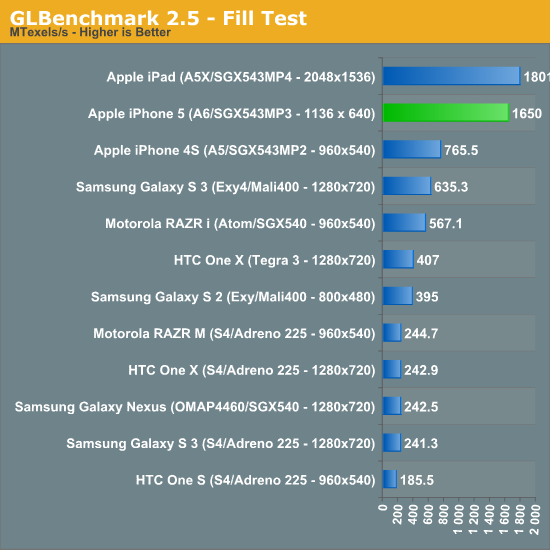
The iPhone 5 nips at the heels of the 3rd generation iPad here, at 1.65GTexels/s. The performance advantage over the iPhone 4S is more than double, and even the Galaxy S 3 can't come close.
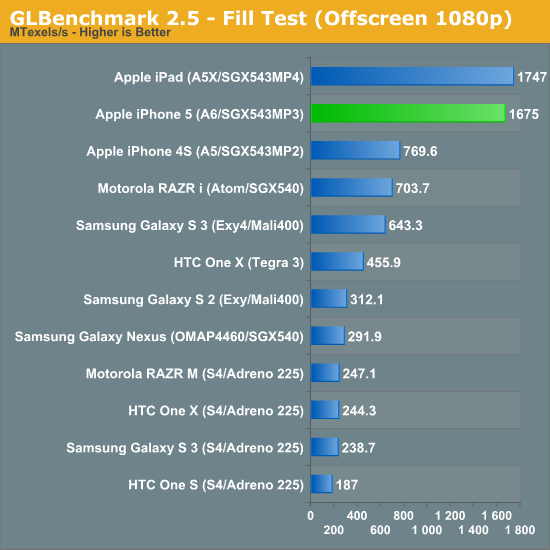
Triangle throughput is similarly strong:

Take resolution into account and the iPhone 5 is actually faster than the new iPad, but normalize for resolution using GLBenchmark's offscreen mode and the A5X and A6 look identical:
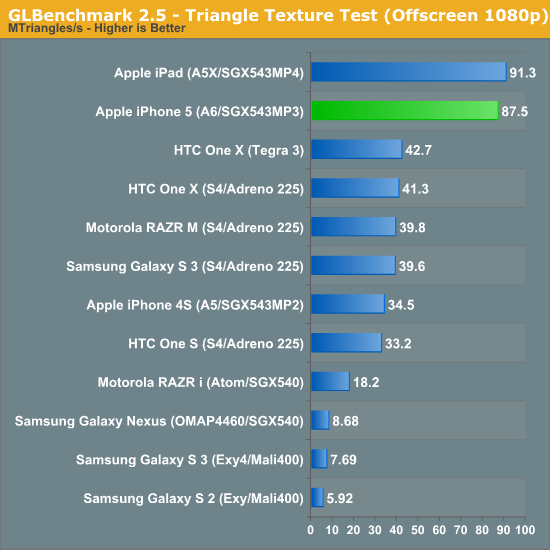
The fragment lit texture test does very well on the iPhone 5, once again when you take into account the much lower resolution of the 5's display performance is significantly better than on the iPad:
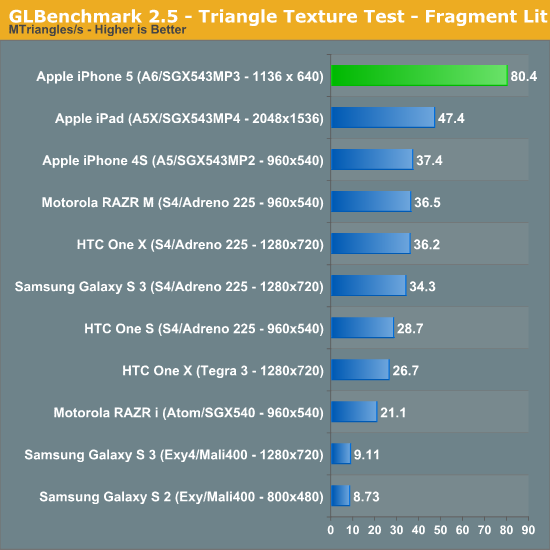
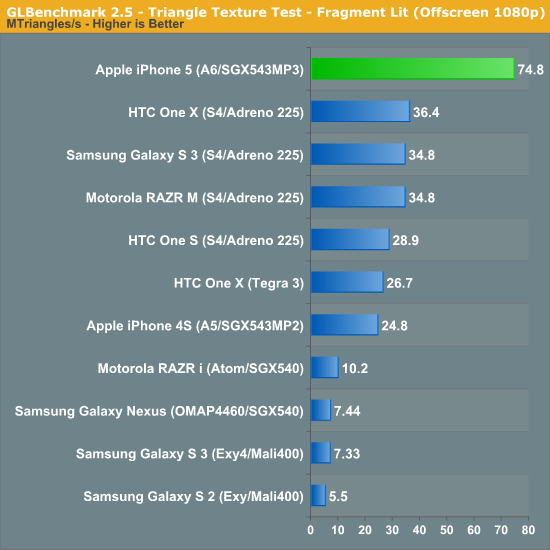

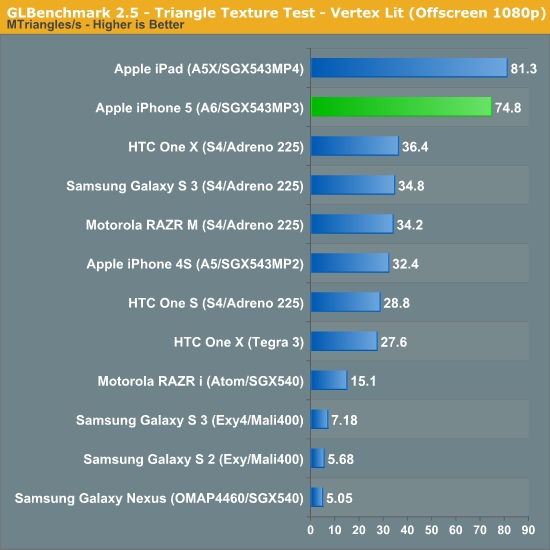
The next set of results are the gameplay simulation tests, which attempt to give you an idea of what game performance based on Kishonti's engine would look like. These tests tend to be compute monsters, so they'll make a great stress test for the iPhone 5's new GPU:
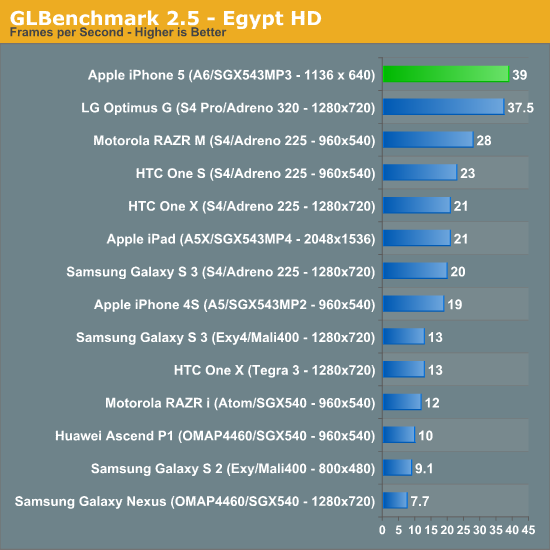
Egypt HD was the great equalizer when we first met it, but the iPhone 5 does very well here. The biggest surprise however is just how well the Qualcomm Snapdragon S4 Pro with Adreno 320 GPU does by comparison. LG's Optimus G, a device Brian flew to Seoul, South Korea to benchmark, is hot on the heels of the new iPhone.
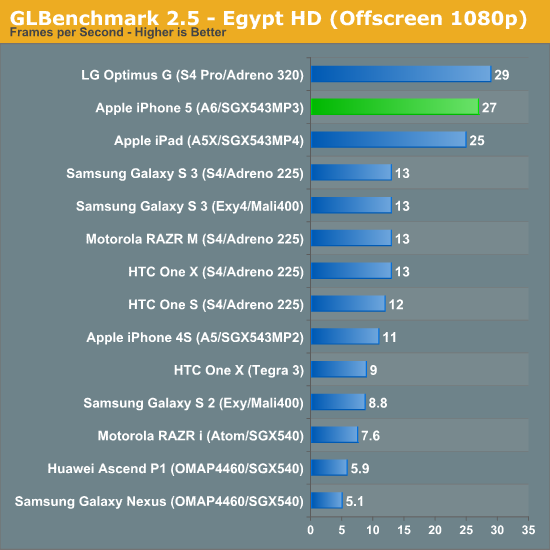
When we run everything at 1080p the iPhone 5 looks a lot like the new iPad, and is about 2x the performance of the Galaxy S 3. Here, LG's Optimus G actually outperforms the iPhone 5! It looks like Qualcomm's Adreno 320 is quite competent in a phone. Note just how bad Intel's Atom Z2460 is, the PowerVR SGX 540 is simply unacceptable for a modern high-end SoC. I hope Intel's slow warming up to integrating fast GPUs on die doesn't plague its mobile SoC lineup for much longer.
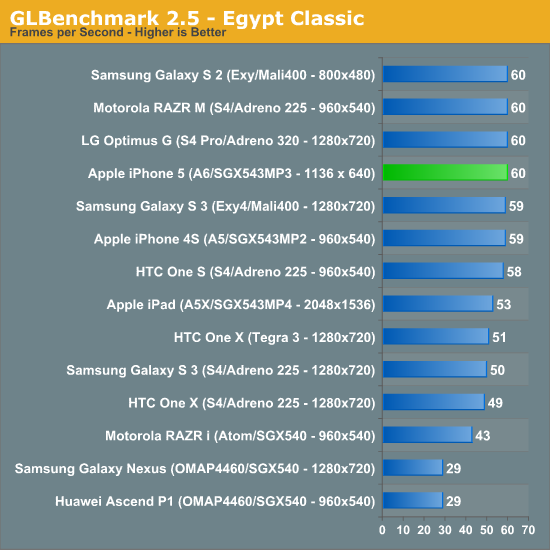
The Egypt classic tests are much lighter workloads and are likely a good indication of the type of performance you can expect from many games today available on the app store. At its native resolution, the iPhone 5 has no problems hitting the 60 fps vsync limit.
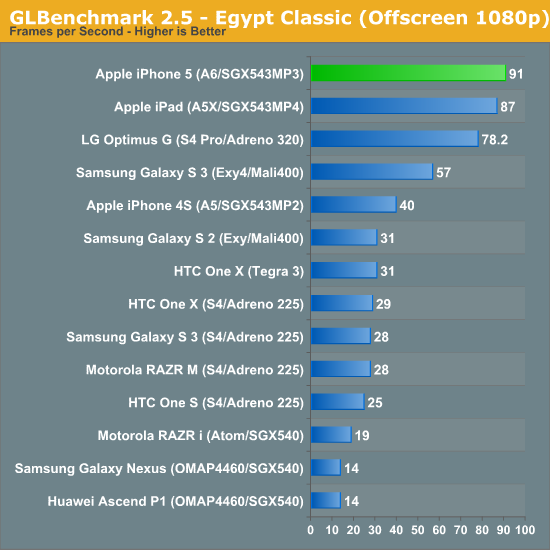
Remove vsync, render at 1080p and you see what the GPUs can really do. Here the iPhone 5 pulls ahead of the Adreno 320 based LG Optimus G and even slightly ahead of the new iPad.
Once again, looking at GLBenchmark's on-screen and offscreen Egypt tests we can get a good idea of how the iPhone 5 measures up to Apple's claims of 2x the GPU performance of the iPhone 4S:
Removing the clearly vsync limited result from the on-screen Egypt Classic test, the iPhone 5 performs about 2.26x the speed of the 4S. If we include that result in the average you're still looking at a 1.95x average. As we've seen in the past, these gains don't typically translate into dramatically higher frame rates in games, but games with better visual quality instead.











276 Comments
View All Comments
name99 - Wednesday, October 17, 2012 - link
If you want to read non-technical reviews, there are a million other sites you can go to, from NYT and WSJ to Engadget and TheVerge.The WHOLE POINT of people reading Anand's reviews is to get tech details we don't get elsewhere.
Perhaps as a followup you might want to suggest that John Siracusa in future limit his OSX reviews to a single letter-sized page?
rarson - Wednesday, October 17, 2012 - link
No, it's not the "WHOLE POINT," the whole point is that reviews are reviews and tech articles are tech articles.GotThumbs - Tuesday, October 16, 2012 - link
"Those longing for an HTC One X or Galaxy S 3 sized device running iOS are out of luck. "I find it hard to believe there is even one person that is in this group. Apple's walled garden is mostly OS and portal based (Itunes).
Especially with Apples maps being sub-standard.
Please stick to facts.
A5 - Tuesday, October 16, 2012 - link
If you don't want any editorial judgement or statements, there are plenty of places where you can just read a spec sheet and benchmark results.Omophorus - Tuesday, October 16, 2012 - link
I think the opposite is more likely... or at least I fall into that category.Mobile computing device aside, Android 4.0+ is shockingly much nicer to use (and this coming from a long time iPhone user) than iOS 5 or iOS6.
If I could get the iPhone 5 handset, maybe with slightly better anodization, running Android 4.0+ I'd be in hog heaven.
After playing with an iPhone 5, I really dig the hardware, but found the software woefully lacking.
crankerchick - Tuesday, October 16, 2012 - link
I think you and the original commenter missed what the statement was saying. It said, "HTC One X or Galaxy S3 'sized' device..."Specifically, a larger screen iPhone, is where I think they were going with the statement, especially given the context of the paragraph where the statement was made.
That said, I'm very much in the same camp as you. My number one device would be an iPhone-size and iPhone-build device running Android (but with a few tweaks since we are talking the ideal device). In fact, that is part of the reason I have an iPhone now and my Galaxy Nexus is sitting in a drawer by the bed--it's just too big and battery life is awful. I want a 4-4.2" 720p screen that doesn't have last year's hardware inside. The One S comes closest, but it's not on VZW to my knowledge, and it's still not "the best" hardware available, which you need with Android, especially on a manufacturer's skinned device.
perpetualdark - Monday, October 22, 2012 - link
What about the Incredible 4g? I think this phone was overlooked because of it's proximity to the S3 release and the fact that the market is generally trending toward a nearly 5" display..I like this phone because it has the current generation of technology, is pretty darn thin, has a replaceable battery, has the 4" display (ie I am not holding a small tablet to my ear or carrying it in my pocket), and is, more importantly, android.
Yes, the SLCD display may not be quite what the apple display is on paper, but to be perfectly honest, I have never noticed the differences.. Perhaps in a test environment, or to someone who calibrates displays all day, the Apple display would be better, I just don't see it.
The s4 processor is not only fast, but plenty efficient, and the battery lasts easily 2 full days of heavy use. I can use it to read a kindle book for 6-8 hours over 2 days, talk a few hours, surf the web a few dozen times, text a few hundred texts, and even play games for an hour or two before I run out of battery. I have yet to go below 40% in one 24 hour period of time with the exception of using it with GPS and maps up.. the gps on 100% burns up the battery fast.
gig of ram, 8 gigs on board storage, 32 more gigs with the sd card, etc, plenty of storage. 8 megapixal camera on back and a vga camera on front.
ICS, LTE, Beats Audio, pretty much all the latest in tech..
No, it can't quite compete with the S3, but it is pretty close to a One X in a 4" package and the closest thing to a One X you can get from Verizon, and honestly the phone that SHOULD be compared to the iphone5, given it is the only one with the current generation of hardware that is the same size. Sure, the iphone5 has an edge on the inc 4g in terms of tech specs, but when you add cost to the mix, the playing field is more level there as well, and to be honest, in real world applications the differences are going to amount to very small percentages.
What people really want is a phone that fits their needs. Usually the most important things are screen size, OS preference, cost, and battery life. Performance is ONLY an issue when there is a problem with it.. Like when the iphone 4 dropped calls and couldn't do internet when you touched it.. The difference from the S4 to the A6 in real world application is a second or two in loading an app.. if even that.. most of my apps open instantly and with chrome and a good 4G connection I am betting that side by side loading web pages would be nearly identical. Specs are cool when comparing e-peen size but otherwise don't mean much in application.
Not everyone is interested in big screens for a phone. Not everyone is interested in having a flexible OS. Not everyone is interested in the latest tech. Not everyone wants to spend a fortune on a phone that is, in practice, marginally better than what they have already. Not everyone is interested in bleeding edge technology. Sometimes you are looking for the phone that best suits YOUR needs. For me, that is an android platform, small form factor to fit in my front pocket comfortably as well as in my hand. A processor that was fast but power conservative. A battery that lasted a full day with reserve to spare, and could be used for 2 or 3 days if conserved well, AND could be swapped with a fully charged battery when travelling. I also like a phone that I can drop and scratch and not notice the dings and scratches.. since I put it in my pocket, I don't want to add a bulky case to keep it safe.. (I have dropped this phone dozens of times and 24" away you would never know it). I like to only pay $6.99 for insurance and be able to replace it if lost or stolen or broken for less than $100 ($12 per month for apple with $170 replacement deductible). And I like that I can use ANY micro-usb charger or cable to charge or connect to a computer. I don't have to buy any special adapters to make it work with my existing devices.
Quite frankly, I think the difference between an android fan and an apple fan is that an android fan will not settle for the one device available to suit his needs, he will shop around to find the RIGHT one. If that happens to be an iphone, that is what he will get. But with dozens of models to choose from that are every bit as good if not better in every way that really matters, the chances of going with an iphone are pretty slim. An apple fan will settle for what is available and try to convince everyone around him that this one device will fit everyone's needs perfectly without exception.
crankerchick - Tuesday, October 16, 2012 - link
I don't follow all the technicals like that, I'm more of an end user when it comes to mobile technology, but I think the trend towards the larger screens is more the MFRs pushing that a selling point (moar moar moar) to cover the fact that they can't fit the latest and greatest and cutting edge (NFC, quad core, LTE, etc) in the chassies of a 4" screen phone.Just my hunch. Wouldn't mind being schooled on this by someone in the know.
KPOM - Tuesday, October 16, 2012 - link
I'd agree with that assessment. Apple was one of the last to move to 3G and one of the last to move to LTE because of battery life. The other manufacturers got around it by building thicker phones in the 3G era, and then with the LTE era started putting in bigger screens, which gave them room for bigger batteries (though the larger displays also required more power). It turned out enough people liked the bigger screens.Now that the power consumption levels are down, it will be interesting to see if others shrink their screens back down to Apple levels. The Galaxy SIII Mini is a half-hearted attempt, as it lacks LTE and has mediocre specs. But maybe someone else will take the bait.
rarson - Thursday, October 18, 2012 - link
I feel like the iPhone 5 screen is actually too small (and I've heard complaints that the phone is too light, which I sort of agree with as well), but I think the Galaxy S3 is too big. I'm still using a Verizon Fascinate. It's got a bigger screen than the 5, but it's a bit smaller than the S2 and S3, perfect size. Thin but not too thin, and light but not too light. In fact, all I really want is a phone exactly like it, but with more power, better battery life, and maybe a slightly better screen (can't complain too much about the screen I already have).When I picked up the Fascinate, I knew it was the phone I wanted (helps that the price was only $50). When the S2 came out, I was excited to see it but disappointed by how much bigger the phone had gotten. I don't want a phone that I have to contort to get into my pocket. Apple's iPhone 5 is great in that respect, but after using this Fascinate for so long, its small size feels a bit cramped.
I'd love to have the hardware of the Apple phone, but proprietary connectors and iOS are absolutely a no-go for me. I really don't care for iOS at all, because Android is so much easier to use.